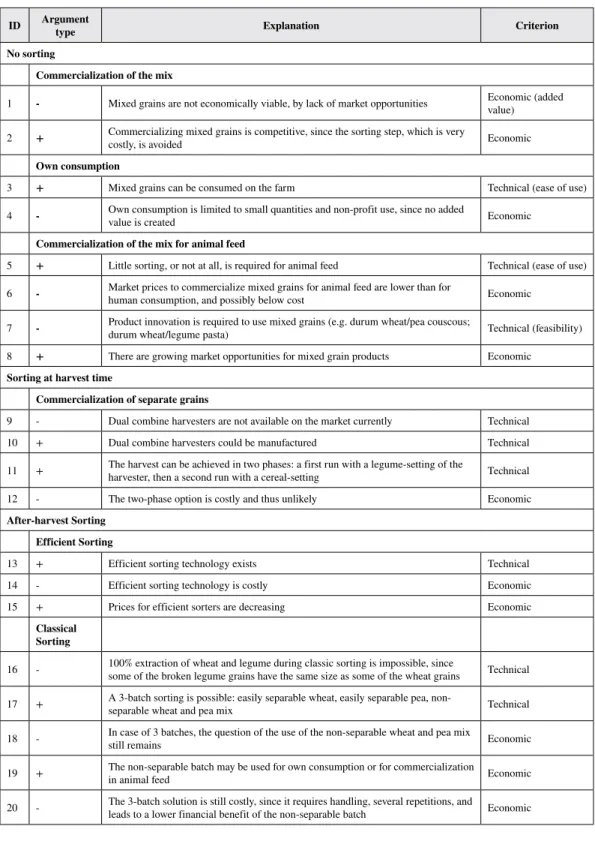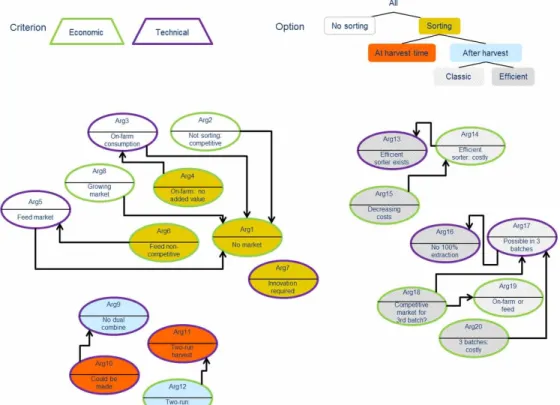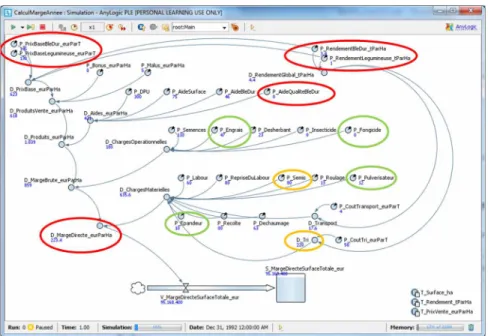HAL Id: hal-01837532
https://hal.archives-ouvertes.fr/hal-01837532
Submitted on 26 May 2020HAL is a multi-disciplinary open access
archive for the deposit and dissemination of sci-entific research documents, whether they are pub-lished or not. The documents may come from teaching and research institutions in France or abroad, or from public or private research centers.
L’archive ouverte pluridisciplinaire HAL, est destinée au dépôt et à la diffusion de documents scientifiques de niveau recherche, publiés ou non, émanant des établissements d’enseignement et de recherche français ou étrangers, des laboratoires publics ou privés.
in the agri-food sector
Rallou Thomopoulos, Bernard Moulin, Laurent Bedoussac
To cite this version:
Rallou Thomopoulos, Bernard Moulin, Laurent Bedoussac. Supporting decision for environment-friendly practices in the agri-food sector: When argumentation and system dynamics simulation com-plete each other. International Journal of Agricultural and Environmental Information Systems, IGI Global, 2018, 9 (3), pp.1-21. �10.4018/IJAEIS.2018070101�. �hal-01837532�
DOI: 10.4018/IJAEIS.2018070101
Copyright©2018,IGIGlobal.CopyingordistributinginprintorelectronicformswithoutwrittenpermissionofIGIGlobalisprohibited.
Supporting Decision for
Environment-Friendly Practices in the Agri-Food Sector:
When Argumentation and System Dynamics
Simulation Complete Each Other
Rallou Thomopoulos, INRA Iate / INRIA GraphIK, Montpellier, France Bernard Moulin, Laval University, Quebec, Canada
Laurent Bedoussac, AGIR, Université de Toulouse, Castanet-Tolosan, France
ABSTRACT High-leveldecision-making,suchaspolicymaking,needstotakeintoaccounttheoften-conflicting interestsofdifferentstakeholderswiththegoaloffindingsolutionstoprovidetrade-offsandbuild consensustowardstheadoptionofso-calledwin-winsolutions.Inthisarticle,theauthorssuggest thatusingamodelingandsimulationapproachwouldgreatlyenrichthedeliberationprocess.The authorsproposeasystematicmethodtoassesspossibleoptions,basedonthecomplementarity ofargumentationmodelingandsystemdynamics(SD)simulation,inconjunctionwithfield experimentation.Asapracticalapplication,theauthorsassessvariousoptionsavailabletoagri-food chainstakeholderswhenconsideringtheadoptionofcereal-legumeintercropsasanalternativetosole crops.Takingadvantageoftheargumentanalysis,SDsimulationsareusedto:1)comparedifferent culturalstrategiesavailabletofarmersincurrentoperating,marketandregulatoryconditions;2) proposeplausiblewhat-ifscenariosanticipatingtechnologicalprogress,andexploringtheimpactof adoptingpotentialincentivesanddissuasiveregulatorymeasures. KEyWORDS
Alternative, Cereals, Explanatory Method, Intercrop, Legumes, Model Integration, Option, Scenario
1. INTRODUCTION Itisrecognizedthatcollaborativemodelingapproachescancreatevalueinagri-foodchains(Filippi &Chapdaniel,2016)inwhichnumerousactorsorstakeholdersinteractandparticipateincoordinated activities(Handayatietal.,2015)tocreateandofferaparticulargoodorservice.However,agri-food chainsarecomplexsystemsinwhichstakeholdersarepronetotensions,conflicts,policythreatsand verticalintegrationpressure(Campbell,2004;Balmannetal.,2006).Approachessuchasconsensus building(Burgessetal.,2003;Campbell,2004)havebeenproposedtohelpincreasestakeholders’ awarenessofcriticalsituationsinagri-foodchains(usuallyindeliberationprocessesrelatedtopolicy making)andtobetterunderstandthedifferentpositionsandviewpointsofthedifferentinvolvedparties.
1.1. Consensus Building Itisalsoacknowledgedthatstakeholderswouldbeinabetterpositiontomakecompromiseifthey werewillingtoreachaconsensus-basedsolutionandiftheyclearlyunderstoodthepositionsofthe differentparties.Consensusbuildingisaconflict-resolutionprocessmainlyusedtosettlecomplex, multipartyissues(Gray,1989).Sincethe1980s,ithasbecomewidelyusedintheenvironmentaland publicpolicyarena.Theprocessallowsvariousstakeholders(partieswithaninterestintheproblem orissue)toworktogethertodevelopamutuallyacceptablesolution(Burgessetal.,2003).The consensus-buildingprocesshelpsstakeholderstoestablishacommonunderstandingoftheattended situation(processwhichisoftencalled‘situationawareness’(Adametal.,1995;Endsley,1995)and tocreateaframeworkfordevelopingasolutionthatworksforeveryone.
1.2. Argumentation Modeling and Visualization Approaches
Gray(1989)showedthatproblemsthatarebestaddressedusingaconsensus-buildingapproachtend tosharesomegeneralcharacteristicssuchas:1)Theproblemsareill-defined,orthereisdisagreement abouthowtheyshouldbedefined;2)Severalstakeholdershaveavestedinterestintheproblems andareinterdependent;3)Stakeholdersmayhavedifferentlevelsofexpertiseanddifferentaccess toinformationabouttheproblems;4)Theproblemsareoftencharacterizedbytechnicalcomplexity andscientificuncertainty;5)Incrementalorunilateraleffortstodealwiththeproblemstypically producelessthansatisfactorysolutions;6)Existingprocessesforaddressingtheproblemshaveproved insufficientandmayevenexacerbatethem. Interestingly,vanBruggenetal.(2003)demonstratethevalueofusingComputer-Supported Argumentation Visualization(CSAV)totackleill-structuredproblems,whichsharealargenumber ofcharacteristicswiththeproblemsaddressedbyconsensus-buildingapproaches(Gray,1989).The mainreasonisthatsolvingill-structuredproblemsresultsfromanargumentativeprocessstarting frominformalreasoning(vanBruggenetal.,2003)andrequiresbuildinganargumentationstructure whichconsists,minimally,ofaclaimwithsupport(e.g.evidentialreasoning).Evaluationofthe argumentscannotbecarriedoutintermsofwhetheranyargumentisrightorwrong,butrequires theevaluatortomakeuseofothercriteriasuchasacceptabilityoftheclaim,andthequalityofthe argumentationwhichisassessedbytakingcounter-argumentsintoaccount.Argument-basedand agent-basedmodelingapproacheshaverecentlybeenproposedtoenhancestakeholderinteractions inagrifoodchains(Bourguetetal.,2013;Thomopoulosetal.,2015;Croitoruetal.,2016).
1.3. The Role of Simulation
Althoughmodelingargumentstructuresandexplainingargumentrelationshipstostakeholdersisquite helpfulinhelpinginvolvedpartiesunderstandeachother’spositionsandfacilitatethedeliberation process(Bourguetetal.,2013),stakeholdershavenomeanstoanticipatetheimpactsofadopting thedebatedsolutions,letalonetocomparethem.Thisiswhereusingmodelingapproachesand simulationsoftwarewouldgreatlyenrichthedeliberationprocess.Asanexampleofsuchmodeling andsimulationapproaches,systemdynamics(SD)hasbeenwidelyusedforthepastfiftyyearsto modelcomplexsocio-economicsystemsandtosimulatetheirbehaviorandevolutioninalargevariety ofdomainsinalmostanydisciplineinvolvingpolicymakingandstrategicplanning(Hirschetal., 2010;Ghaffarzadeganetal.,2011;Marshalletal.,2015).Forexample,SDhasbeenusedtoassess foodsystemvulnerabilities(Staveetal.,2015).However,ourliteraturereviewhasnotfoundanyDSS methodorsoftwarethatintegratesargumentationmodeling/reasoningandvisualizationtechniques andtoolswithSDanalysisandsimulationsoftware.
1.3. Aim and Structure of the Paper
Theobjectiveofourworkistodevelopanintegratedapproachandtocreateadecisionsupport softwaretohelpstakeholderscreateacommonsituationawarenessandpossiblybuildconsensus,
whiletakingintoaccounttheconflictingviewpointsoftheinvolvedparties.Theproposedapproach isbasedoncomplementarymodelingandsimulationtechniques,namelyargumentationmodelingand visualization,SDmodelingandsimulation.Inthispaperwepresentthemainstepsoftheproposed approachandshowitsapplicationinacasestudywhereargumentationmodelingandSDsimulation areusedtoassessandcomparevariousoptionsavailabletofarmersforcereal-legumeintercrops withrespecttothecorrespondingsolecropalternatives.Thepaperisorganizedasfollows.Section3 presentstheagri-foodcasestudy.Section4detailsthemethodologicalstepsofourapproach.Section 5presentsitsapplicationonthecasestudy. 2. CASE STUDy
2.1. The Intercropping Debate
Intercropping(IC)isthesimultaneousgrowthoftwoormorespeciesinthesamefieldduringa significantperiodoftime.Itagreeswithecologicalprinciples.Thispracticeisparticularlysuited inlownitrogeninputsystemswhereitoptimizestheuseofNresourcesthroughN2fixationof legumesleadingtoimprovedandstabilizedyieldsandincreasedcerealproteincontent(Bedoussac etal.,2015).Nevertheless,despitetheirnumerousagronomicinterestswidelydemonstrated, intercropsarestillonlyslightlyadoptedbyfarmers,exceptforanimalfeedingand/orinorganic farming. Indeed, the main stakeholders still question the potential economic advantage of intercroppingbecauseitdependsonmanyfactorssuchasthedifferencebetweencropprices, thecostofefficientlyseparatingthegrains,butalsoonthepricesofchemicalinputsandthe amountofavailablesubsidies. Alargenumberofargumentsforandagainstcereal-legumeintercroppinghavebeenexpressed bythemainstakeholdersofthesupplychain,notablyintechnicalarticles(Pelzeretal.,2014; PerfComProject,2012).Moreover,variousaspectsofintercroppinghavebeendiscussedina recentreview(Bedoussacetal.,2015),includinggrainproduction,proteinconcentration,weed reduction,useofnitrogenandlightresources,effectsoflow-inputsystems,croprotationdesign, andeconomicbenefits.Inthiscontextitisimportanttonotethatintercroppingadoptionis influencedbypublicandprivateinterests.Theecologicalbenefitsofintercroppingareofgreat importancewhenconsideringcollectiveinterestandrelatedpublicdecisionmaking.However, theyinterferewithfarmers’privateinterestswhich,firstandforemost,dependontheeconomic viabilityofintercropping. Theseobservationsmotivatedourresearchandledtoourproposalforadeeperassessmentof thesituationbasedon:1)theanalysisofargumentsputforwardbydifferentreliablestakeholder groupsinfavororagainsttheadoptionofspecificpractices(thatwewillcall‘options’)oragricultural decisionsbythemainconcernedactors(i.e.farmers);2)thedevelopmentofmodelstocreate scenariosthatsimulatehowtheavailableoptions/decisionsmightinfluencetheactors’operations; 3)thecomparisonoftheoutcomesofthesescenariostoinformthemainstakeholders’decision process(i.e.farmersandpublicpolicymakers)withrespecttothedebatedissues.Therefore,inthis article,weputtheemphasisonfarmers’economicinterestbyconsideringhowtheirgrossmargin canevolveunderseveralhypotheses.Amongthesehypotheses,weconsiderpublicinterventions (bymeansofincentiveordissuasivemeasures)thatexpressthewillingnessofpublicauthoritiesto takeintoaccounttheeconomicviabilityofintercroppingforfarmers,whichisamajorbottleneck forintercroppingadoption.Inthepresentstudywespecificallyaddressthecaseofintercroppingof durumwheatandlegumes,sinceitrepresentsanalternativetoproducing:1)durumwheatasasole crop,usuallyfertilizedwithlargeamountsofnitrogenandpesticidesand2)grainlegumesthatcan reducethedependencyonnitrogen,butwhosecultivatedsurfacehasstronglydecreasedduringthe lastdecades,notablybecauseoftheirinstableyields.
2.2. Agronomic Experimentation of Different Cultural Alternatives Sincemostfarmsoperatingatanindustrialscalepracticeextensivecerealsole-crop,thereisalackof practicalandhistoricaldatadocumentingtheoutcomesofcereallegumeintercropping.Thislackof datawasanobstacletothescientificexaminationofimportantargumentsrelatedtoculturalpractices putforwardintheintercroppingdebate.Inthiscontext,afieldexperimentwasconductedin2007-2008byoneofourteammemberstoassessdifferentintercroppingstrategies,takingintoaccount differentculturalpossibilitiesthatcanplausiblybechosenbyfarmers.Themainobjectiveofthe experimentwastocompareintercroppingefficiencytosolecroppingstrategiesinordertoproduce durumwheatwithsufficientgrainproteinconcentrationinlowinputsystems. Inthispaperweonlycompareoneofthetestedintercroppingstrategieswiththesolecropping strategythatwillbeusedasareferencebase.Herearethetechnicaldetailsofthesestrategies: • Durumwheat(cvNeodur)intercroppedwithwinterpea(cv.Lucy)issowninonetimetoreduce sowingcost.Thetwospeciesweresownathalfoftheirsolecropdensity(168grain.m-2forwheat and36grain.m-2forpea).Accordingto(BedoussacandJustes,2010),35kgmineralN.ha-1were appliedatthe‘visibleflagleaf’wheatstagecorrespondingtothebeginningofpeagrainfilling sincethislatesupplyallowstoimprovethewheatgrainproteincontentwithoutaffectingthe legumeyield.Chemicaltreatedseedswereusedaltogetherwithoneapplicationofherbicide beforeemergence,butnoinsecticideandnofungicidewereapplied.
• Durumwheatlowinputsolecrop(cv.Neodur)sownat336grain.m-2andfertilisedwith75kg mineralN.ha-1(40kgN.ha-1atstageear1cmofwheatand35kgN.ha-1atthe‘visibleflagleaf’ wheatstage).Treatedseedswereusedaltogetherwithoneherbicidebeforeemergenceandtwo fungicidestopreventwheatdiseases.
Grainyieldwasmeasuredatharvesttimeandeconomicalevaluationwasperformedconsidering mechanicalcosts:60€.ha-1forplowing;93€.ha-1forsoilpreparation;40€.ha-1forsowingthesole croppedwheatand80€.ha-1forthetwopassesintheintercrop;12€.ha-1foreachsprayingtreatment (12€.ha-1fortheintercropand36€.ha-1forthesolecroppedwheat);10€.ha-1foreachnitrogen application(10€.ha-1fortheintercropand20€.ha-1forthesolecroppedwheat);80€.ha-1forthe harvest;63€.ha-1forstrawincorporationdoneinthreepasses;4€.t-1fortransportand50€.t-1to separatethegrainsoftheintercrops.
Operationalcostsincluded:110€.ha-1forseedsinbothsolecropandintercrop;1.33€.kg-1of nitrogen(47€.ha-1fortheintercropand100€.ha-1forthesolecroppedwheat);23€.ha-1forherbicide inbothsolecropandintercropand88€.ha-1forfungicidetreatmentsinthesolecroppedwheat.
Theestimatedcroppriceswerebasedonreferencesobtainedfromcollectorsonaverageforthe 2004-2007period:145€.t-1forthewheatand130€.t-1forthepea.Wealsotookintoaccountthat wheatpricedependsonitsquality(grainproteincontent,specificweightandvitrousness)leading toafinalpriceof141.5€.t-1fortheintercroppedwheatand139.7€.t-1forthesolecroppedwheat. Finallythesubsidiesincluded:300€.ha-1fortheSingleFarmPaymentinbothsolecroppedwheatand intercrop;75€.ha-1forunirrigatedsurfacesubsidy;46€.ha-1forthedurumwheatsubsidyinbothsole croppedwheatandintercropand26€.ha-1forthedurumwheatqualitysubsidyonlyinthesolecrop.
2.3. Experimentation Results
Theintercropgrainyieldwas4.45t.ha-1including1.02t.ha-1ofpea.Itwaslowerthanthe5.81t.ha-1 ofthesolecroppedwheat.Nosignificantdifferencewasfoundinthegrainproteincontentwith 13.5%forthesolecroppedwheatand13.3%whenintercropped.However,wemustrememberthat theintercropreceivedtwotimeslessnitrogenthanthesolecroppedwheat.Thisresultagreeswith otherresultsintheliterature(Bedoussacetal.,2016),confirmingthatintercroppingismoreefficient thansolecroppinginlownitrogeninputsystems.
Letusemphasizethatthegrainyieldadvantageofintercroppingisnottheonlyelementtaken intoaccountbyfarmerswhendecidingtoadoptordiscardanintercroppingstrategy.Indeed,their decisionreliesonabroaderviewoftheeconomicequation,takingintoaccountanumberofother elementssuchasoperationalcosts,sellingratesandthe(non-)availabilityofgovernmentalsubsidies, tonameafew. Asshowninthenextsection,theseexperimentaldatawillbeusedtosetsomeparametersofthe SDmodelswhicharedevelopedtosimulatescenariosenactingdifferentvariationsoftheintercropping strategiesthatmaybeadoptedbyfarmers.
3. A NEW APPROACH BASED ON ARGUMENTATION AND NUMERICAL SIMULATION
Inpractice,stakeholdershavenomeanstoanticipatetheimpactsofadoptinganyofthedebated solutions.Tothisend,wesuggestthatusingmodelingapproachesandsimulationsoftwarewould greatlyenrichthedeliberationprocess.AmongthemaininterestsofchoosingSystemDynamicsin thiswork,letusmention:(1)explicitformalizationofallvariables,withasconsequence(2)formal linkwiththeargumentsmadepossiblebytheexplanationofthevariables,allowing(3)graphical visualizationofthevariablesand(4)choiceofthetimestepofthesimulationthatcanbestoppedat thechosentime,inorderto(5)testscenariosimmediatelybyvaryingthevalueofchosenvariables. Inthecontextoftheintercroppingdebate,weproposesuchanintegratedapproachtohelpfarmers andpublicpolicymakerstoassessdifferentscenariosaboutmeasuresthatcouldpromotecereal-legume intercropswithrespecttothecorrespondingsolecropalternatives.Inlinewithpreviousworksrelated totheinfluenceofpublicinterventionintheagriculturesector(Caseyetal.,1999;Chambers,2002), weanalyzeandcomparetwoscenarios,namelyincentiveversusdissuasivepublicpolicymeasures, andconcludeonanintermediateone,whichcanprovideafreshviewoftheintercroppingdebate. Theproposedmethodiscomposedoffourmainstepsthatarepresentedinthissection.
3.1. Setting the Objectives and Scope of the Study
Thisstepiscomposedofanumberofsub-tasks,illustratedhereonourcasestudy:
• Objectives of the Study:1.Identifyobstaclesthatpreventfarmersfromadoptingcereal-legume intercroppingpractices;2.Studyregulationmeasuresthatcouldpromotecereal-legumeintercrops withrespecttothecorrespondingsolecropalternatives.
• The Main Debated Issues:Wecallthemthe‘intercroppingdebate’:1.Ecologicalbenefits ofcereal-legumeintercroppingwithrespecttocerealsolecrops;2.Economicviabilityof intercroppingundercurrentfarmers’operatingconditions,cereal/legumemarketand(un-) availabilityofincentives/subsidies.
• Interested Stakeholders:PublicPolicymakers,Farmers’groups.
• Selected Actors:Farmersinterestedinadoptingcereal-legumeintercroppingpractices. • Preliminary Characterization of the Selected Actors’ Situation:Syntheticviewofthefarmer’s
financialsituationthroughtheanalysisofthehalf-netmargin.
• External Forces Influencing the Selected Actors’ Situation:Marketsforcerealandlegumes, technologicaladvances(forexampleefficientsortersformixedgrains),financialaids(i.e. incentives,subsidies),environmentalandclimaticconditions. • Preliminaryidentificationofoptionsavailabletotheselectedactors: ◦ Mainculturaloptions:1.Durumwheatsolecrop;2.durumwheatandwinter peaintercropping. ◦ Maincommercialisationoptions:1.Durumwheatmarket(themostattractivemarket,but dependingonthequalityofproducedgrains);2.Winterpeamarket;3.Currently,nomarket
fordurumwheatandpeamixedgrainsforhumanconsumption;4.lessattractivemarketfor mixedgrainsforanimalconsumption.
• Identificationofdocumentationandresources:Manypapersandreportssupportingorattacking eitheroption,butnoconclusivestudyorrecommendation.
3.2. Argument Collection and Selection of the Most Relevant ones Exploiting Argumentation Systems
Inordertobetterunderstandtheintercroppingdebateweperformedanextensiveliterature review(seeSection3.1)andcarriedoutinterviewswithdomainspecialiststocollectand organize the various arguments put forward by the different stakeholders and specialists. Then,theargumentanalysiswasperformedinfoursteps:1.themainargumentsinfavorand againstcereal-legumeintercropswereidentified;2.argumentswererefinedandstructuredin argument/optiontableswhichestablishalinkdecisionsthattheselectedactorsmaymake;3. thecontentsoftheargument/optiontablesweredisplayedintheformofargumentationsystems thatcanbeevaluatedintermsofcoherenceandcompletenessusingtheargumentationtheory (Dung,1995),whichledustoselectasub-setofargumentsthatweredeemedrelevantinthe contextofourstudy;4.finally,weanalysedtheselectedargumentstoraisesomehypotheses thatcanbeplausiblyconsideredwhenexploringdifferentoptionsavailabletofarmerswhen adoptingcereal-legumeintercroppingpractices.Thesehypothesesareusedtosetparameter valuesinthenumericalsimulations.
3.3. Numerical Simulations of Reference Scenarios
Tohelpstakeholdersbetterunderstandhowthechoiceofeitherculturalstrategymayinfluencethe situationoftheselectedactors(i.e.farmers),weproposetofirstdevelopaSystemDynamicsmodel (SDmodel)thatemphasizesthemainelementsoftheselectedactors’situation.Then,weusethe modeltosimulatescenarioscorrespondingtotheoptions(i.e.culturalpractices)thatmaybechosen bytheselectedactors.Thisstepisdividedintoseveralsubtasks: • Inordertomodeltheselectedactors’situation,identifythemainvariablesthatcharacterize theirdecisionmakingprocess.Someofthesevariablesmaybeundertheactor’scontrol,while othervariablesreflecttheinfluenceofexternalfactorssuchasmarketprice,costsofequipment andfertilizers. • CreateaSDmodelofthedecisionmakingprocessusingthesevariablesandtakingintoaccount theirinteractions.TheSDmodelisthencalibratedusingwell-knowndatasets.Inthepresent studyweusedavailablehistoricaldatatocomputethefarmer’sgrossmargininthecaseofdurum wheatsolecropusinglownitrogeninput. • Selectplausibletechnicalhypotheses:Informationfromvarioussources(interviewswith stakeholders,publiclyavailablehistoricalstatistics,etc.)isusedtoidentify:1.plausiblehypotheses tosetkeyexternalfactorsoftheSDmodel(suchasthemarketpricefordurumwheatandfor peas);2.plausibleoptionsfortheselectedactorsthatareexpressedintermsofvaluesassigned tovariablesundertheactors’controlintheSDmodel.Havingsetthesehypotheses,theSD modelcanbeadjusted.
• Run SD simulations: Using the SD model and data obtained from the agronomic experimentation,wecarriedoutsimulationsforthetwomainculturalstrategiesthatare discussedintheintercroppingdebate:1.durumwheatsole-cropand2.durumwheatand winterpeaintercropping.Thescenariosthatresultfromthesesimulationsarecalledreference scenariossincetheyareusedasabasisforthecomparisonoftheresultsofWhat-ifscenarios presentedinthenextsub-section.
3.4. What-If Analysis and Conclusion of the Study Thereferencescenariosareusedtocompare,fromthefarmer’spointofview,theoutcomesofapplying eitherculturalalternatives,giventheconditionscurrentlyprevailinginthemarket,intheindustry andthe(non-)existenceofpublicincentivesandsubsidies.TheobjectiveoftheWhat-ifanalysis stepistoexplorehowchangesoccurringinsomeoftheseconditionsmayinfluencetheoutcomesof applyingeitherculturalalternative.Herearethesub-tasksproposedtocarryoutthewhat-ifanalysis. • Select Plausible What-if Hypotheses:WesuggesttofirstsetwhatwecallWhat-ifhypotheses
thatcanformalize:1.plausibletrendsofcertainexternalforces(suchastechnologicalinnovation andrelateddecreaseofequipmentcosts);2.certainmeasuresthatcanbeplausiblyadoptedby publicauthoritiestopromotecereal-legumeintercrops.
• Perform What-if Scenarios:TheSDmodelisadjustedaccordingtoeachchosenWhat-if hypothesisandruntosimulatethecorrespondingWhat-ifscenario.Indeed,differentWhat-if scenarioscanbeexplored.TheycorrespondtovariationsoftheSDmodelwithdifferentvalue combinationsoftheabovementionedexternalfactorsandcontrolledvariables.Thefinalstate ofascenarioisexpressedintermsofvariablesthatrepresenttheoutcomeofthescenarioon theselectedactor’ssituation. • Conclude:ThecomparisonofthefinalstatesoftheWhat-ifscenariosallowsfortheassessment ofthedifferentoptionsavailabletotheselectedactors(i.e.farmers)andinfluentialstakeholders (i.e.publicauthorities),whiletakingintoaccountthedifferenthypothesesthatwereset.Onthe basisofsuchacomparison,analystscandrawconclusionsinrelationtothedebatedissuesand proposerecommendationstothestakeholdersinterestedinthestudy.
4. APPLyING THE ARGUMENTATION AND SIMULATION APPROACH ON THE CASE STUDy
Inthissectionwepresentandbrieflyjustifytheargumentationframeworkthatweuseinourapproach. Then,weillustratehowourapproach(Section4)hasbeenappliedtothecasestudy(Section3)by presentinganddiscussingthemainresultsthatwereobtained.
4.1. A Few Words About the Argumentation Formalism Used in this Approach
Letusrecallthatanargumentationsystemisusuallyrepresentedasanorientedgraphwherenodes areargumentsandedgesareattackrelationsbetweenarguments.ConsideringDung’sseminalwork onargumentation(1995),anargumentandtheattackrelationareabstractandcanbeinstantiatedand definedindifferentwaysindifferentcontexts(Walton,2009).Dunghimselfstated:“…anargument isanabstractentitywhoseroleissolelydeterminedbyitsrelationstootherarguments.Nospecial attentionispaidtotheinternalstructureofthearguments…”Forexample,anargumentcanbeaset ofstatementscomposedofaconclusionandatleastonepremise,linkedbyaninferenceoralogical relation.Attackinganargumentcanbeachievedindifferentways:1.byraisingdoubtsaboutits acceptabilitythroughcriticalquestions;2.byquestioningitspremises;or3.byputtingforwardthat thepremisesarenotrelevanttotheconclusion.Stillanotherwaytoattackanargumentistopresent anargumentwithanopposingconclusion.Inthislattercase,whenargumentssupportdifferent conclusions,anattackrelationissaidtoexist. Althoughtheoreticallysound,applyingDung’sframeworkinanindustrialcontextisnot straightforward;oneoftheinitialdifficultybeinghowtopracticallydefineanargumentinorderto reflectstakeholders’statementsinadebate.Unfortunately,thereisstillnogeneralmodelthatcanbe usedtoformalizeanaturalargument(i.e.anargumentstatedbyastakeholderduringadiscussion innaturallanguage)andinputinanabstractargumentationframeworkinarealdecision-making context.QuotingBaroniandGiacomin(2009):“Whiletheword‘argument’mayrecallseveral
intuitivemeanings,liketheonesof‘lineofreasoningleadingfromsomepremisetoaconclusion’or of‘utteranceinadispute’,abstractargumentsystemsarenot(evenimplicitlyorindirectly)boundto anyofthem:anabstractargumentisnotassumedtohaveanyspecificstructurebut,roughlyspeaking, anargumentisanythingthatmayattackorbeattackedbyanotherargument…”Indeed,thestructure ofanabstractargumentdonotcorrespondtotheintuitiveunderstandingofwhatanargumentis; andthenotionof“attackbetweenarguments”doesnothaveanaturalanddirectcorrespondenceto practicalexpressionsusedbystakeholderswhendebating.Moreover,representingargumentsasan orientedgraphcanbeadifficulttaskforstakeholders:whenthenumberofargumentsand/orattacks islarge,thegraphbecomesillegibleanddifficulttointerpretbystakeholders. Inourproject,weneededtofindapracticalwayofdefiningargumentsthatareusedintheprocess ofdecisionmaking.Insuchacontext,argumentscanbeintuitivelythoughtofasbeingstatements tosupport,contradict,orexplainopinionsordecisions(Amgoud&Prade,2009).Moreprecisely,in decisionalargumentationframeworks(Ouerdaneetal.,2010),theargumentdefinitionisenriched additionalfeatures,namelythedecision(alsoreferredtoas‘action’,‘option’or‘alternative’)andthe goal(alsoreferredtoas‘target’).Inotherstudiesargumentsarealsoassociatedwithspecificactors. Anapplicationofadecision-orientedargumentationframeworktoareal-lifeproblemconcerning foodpolicycanbefoundinBourguetetal.(2013),wherearecommendationregardingtheprovision ofwhole-grainbreadwasanalyzedaposteriori.Inthiscase,eachargumentisassociatedwiththe actionitsupports.Basedontheaboverationale,wechosetospecifyanargumentasatuplecomposed ofanidentifier,atype,anexplanation,acriterion,anoptionandasub-option.Formally: Anargumentisatuplea=(I;T;E;C;O;S)where: • Iistheidentifieroftheargument; • Tisthetypeoftheargument(withvaluesin favouroragainstanoption); • Eistheexplanationunderlyingtheargument; • Cisthecriterionwhichtheargumentrelieson; • istheoption(i.e.thedecision)consideredbytheargument; • Sisthesub-optionconsideredbytheargument. Foranyargumenta,wedenotebyI(a),T(a),E(a),C(a),O(a),S(a)respectivelytheidentifier, thetype,theexplanation,thecriterion,theoptionandthesub-optionofargumenta. AsanillustrationTable1displaysthesetofargumentsconsideredinourcasestudy.Moredetails abouthowourargumentmodelisappliedtothecasestudyareprovidedinSections5.2and4.3.
Now, let us consider the attack relation. In structured argumentation (i.e. logic-based argumentationframeworkswhereargumentsareobtainedasinstantiationsoveraninconsistent knowledge base) three kinds of attacks have been defined: undercut, rebut and undermine (Besnard&Hunter,2008).Theintuitionoftheseattackrelationsiseithertocounterthepremise oftheopposingargument(‘undercut’),theconclusion(‘rebut’)ortoattackthelogicalstepsthat allowedtheinferencebetweentheargument’spremiseandconclusion(undermine).Inabstract argumentationthesetofattacksissimplyconsideredasprovideda priori.Anotherpossibilitythat canbeconsideredistoenhancetheargumentationframeworkwithasetofpreferences,expressed forinstanceasweightsrepresentinguncertainty.Inourprojectweneededtochooseapractical waytodefinetheattackrelation.Consideringtherealityofstakeholders’debatesandourmodel toformalizearguments,wechosetomodeltheattackrelationinthefollowingway.Attackingan argumentisachievedby:1)raisingdoubtsabouttheacceptabilityofthesub-optionitsupports and2)expressingacounter-argumentafterit,chronologicallyspeaking.Formally,weconsider thefollowingattackrelation: Letaandbbetwoarguments.Wesaythataattacksbifandonlyifthefollowingthreeconditions aresatisfied:
1. O(a) = O(b);
2. [S(a) = S(b)andT(a) ≠ T(b)]or[S(a) ≠ S(b)andT(a) = T(b)]; 3. awasexpressedafterb. Thefirstconditionexpressesthatargumentsaandbsupportthesameoption.Thesecond conditionexpressesthataandbareoneinfavourandtheotheragainstthesamesub-option,orboth infavour(resp.against)differentsub-options.Thethirdconditionavoidsobtainingasymmetric attackrelationbytakingintoaccountthetimewheneachargumenthasbeenexpressed,hencewe considerthe‘chronology’ofarguments. Consideringthesenotations,wepresentinthefollowingsub-sectionshowourapproachhasbeen appliedtothecasestudypresentedinSection3.
4.2. Argument Collection and Structuration
Thecollectionofproandconargumenthighlighteddifferentcategoriesofconcerns.Asanexample, thehindrancetothedevelopmentofcereal-legumeintercropsincludedimportantcategoriesof arguments:1)legalconcerns;2)technicalissuessubdividedintocalendar-relatedandequipment-relatedconsiderations;3)commercialopportunitiesand4)doubtsaboutthelong-termviabilitywithin rotations.Usingtheresultsoftheargumentcollection,werecommendtobuildargumenttablesthat showwhichargumentsareusedtodebateaboutpossibledecisions(alsodenoted“options”);i.e. whichargumentssupport,orareagainst,eachoption(orsub-setofoptions).Identifyingintheset ofargumentsthepotentialoptionsthatareavailabletotheselectedactorsisanimportantactivityof theargumentanalysisstep.Indeed,thisenablestheanalysttoestablishanexplicitlinkbetweenthe argumentsandimportantactions/decisionsthatarepartsoftheselectedactors’decisionprocess.As anexample,wecanidentifycertainoptionsavailabletofarmerssuchas:‘Withsorting’or‘Without sorting’[themixedharvest],andifthesortingoptionhasbeenchosen,which[sorting]technique touse,when(atharvesttime,post-harvest)andwhere[atwhichscale].Asanillustration,Table1 showsasubsetofargumentsthatareinfavororagainst3optionsavailabletofarmers:(1)nosorting; (2)sortingatharvesttime;(3)afterharvest.Inthelattercase,thesortingmaybeefficientorclassic, andbothoptionsareconsidered. InTable1weseethateachargumentisdisplayedwith:anidentifier(‘ID’);anArgumenttype (‘+’ifitisinfavor;‘-’ifitisagainsttheoption);an‘Explanation’(ashortsentencesummingupthe argument);anda‘Criterion’whichcategorizestheargument(asforexample‘economic’or‘technical’). Theoptionsappearonlinesofthetable(printedinbold),asforexample‘Nosorting’,‘Sortingat harvesttime’and‘After-harvestsorting’.Becauseargumentsmaysupportorattackacombination ofoptions,wemayalsoneedtodisplaysub-optionsofagivenoption.Forexample,underthe‘No sorting’optionweseeinTable1threealternativesub-options:‘Commercializationofthemix’,‘Own consumption’and‘Commercializationofthemixforanimalfeed’.Thismeansthattheseentries displayargumentsinfavorandagainsteachcombinationoftheoptionanditssub-options.Indeed, incertaincasessub-optionsmayhave‘sub-sub-options’andchainsofoptionscanbedisplayedina tree-likeform.Wediscoveredthatorganizingthetableinthiswayputstheemphasisontheexistence ofportionsoftreestructuresthatwerederivedfromtheanalysisoftheargumentsinitiallycollected fromvarioussources.Thisisaninnovativewayofrepresentingsetsofargumentsinatabularform thatestablishesalinkbetweentheargumentsandchainsofdecisionsthattheselectedactorsmay makeintheirdecisionprocess. Oncetheargument/optiontablesformalized,wecanbuildnetworksofargumentsinorder toanalysethecoherenceoftheargumentssupportingtheoptionsavailabletotheselectedactors. Networksofargumentsconstituteagraphicalrepresentationofargumentationsystemsthathavebeen studiedformanyyearsbytheartificialintelligencecommunity,expandingDung’sseminalproposal (Dung,1995).Anargumentsystemformalizesargumentsandcounter-arguments,usingabinary relationcalled‘‘attack’’whichreflectsconflictsamongarguments.Anargumentationsystemisthus
Table 1. Argument/Option table structuring the arguments debating the following options: (1) no sorting; (2) sorting at harvest time or (3) after harvest
ID Argument type Explanation Criterion
No sorting
Commercialization of the mix
1 - Mixedgrainsarenoteconomicallyviable,bylackofmarketopportunities Economic(addedvalue) 2 + Commercializingmixedgrainsiscompetitive,sincethesortingstep,whichisverycostly,isavoided Economic
Own consumption
3 + Mixedgrainscanbeconsumedonthefarm Technical(easeofuse) 4 - Ownconsumptionislimitedtosmallquantitiesandnon-profituse,sincenoaddedvalueiscreated Economic
Commercialization of the mix for animal feed
5 + Littlesorting,ornotatall,isrequiredforanimalfeed Technical(easeofuse) 6 - Marketpricestocommercializemixedgrainsforanimalfeedarelowerthanforhumanconsumption,andpossiblybelowcost Economic
7 - Productinnovationisrequiredtousemixedgrains(e.g.durumwheat/peacouscous;durumwheat/legumepasta) Technical(feasibility) 8 + Therearegrowingmarketopportunitiesformixedgrainproducts Economic
Sorting at harvest time
Commercialization of separate grains
9 - Dualcombineharvestersarenotavailableonthemarketcurrently Technical 10 + Dualcombineharvesterscouldbemanufactured Technical 11 + Theharvestcanbeachievedintwophases:afirstrunwithalegume-settingoftheharvester,thenasecondrunwithacereal-setting Technical 12 - Thetwo-phaseoptioniscostlyandthusunlikely Economic After-harvest Sorting Efficient Sorting 13 + Efficientsortingtechnologyexists Technical 14 - Efficientsortingtechnologyiscostly Economic 15 + Pricesforefficientsortersaredecreasing Economic Classical Sorting
16 - 100%extractionofwheatandlegumeduringclassicsortingisimpossible,sincesomeofthebrokenlegumegrainshavethesamesizeassomeofthewheatgrains Technical 17 + A3-batchsortingispossible:easilyseparablewheat,easilyseparablepea,non-separablewheatandpeamix Technical 18 - Incaseof3batches,thequestionoftheuseofthenon-separablewheatandpeamixstillremains Economic 19 + Thenon-separablebatchmaybeusedforownconsumptionorforcommercializationinanimalfeed Economic 20 - The3-batchsolutionisstillcostly,sinceitrequireshandling,severalrepetitions,andleadstoalowerfinancialbenefitofthenon-separablebatch Economic
definedasapairAS=(A,R)whereAisasetofargumentsandR⊆A×Aisanattackrelation.An argumentαattacksanargumentβifandonlyif(α,β)∈R.Hence,anargumentationsystemcanbe representedbyanetworkwhosenodesareargumentsandorientededgesrepresenttheattackrelation betweenarguments. Forexample,Figure1showstheargumentationsystemwhichformalizesthesub-debateonsorting optionsandderivesfromtheinformationpresentedinTable1.Twopartscanbedistinguishedin thefigure.TheupperpartofFigure1servesasalegendandprovidescolorcodes.Onthelefthand sidetwocriteriaaredisplayed:economic(greenoutline)andtechnical(purpleoutline).Ontheright hand-sideahierarchyofoptionsisdisplayed:nosorting(whitebackgroundcolor),sorting(yellow background),atharvesttime(orangebackground),afterharvest(bluebackground),classic(dotted background)andoptical(dashedbackground).Theoptionsareorganizedinahierarchicalwaythat showsthechainofdecisionsthatcanbemadebytheselectedactors. ThelowerpartofFigure1displaystheargumentationsystem.Eachargumentisrepresentedby anoval,labeledbyitsIDandashorttitle(refertoTable1forthedetails).Thebackgroundcolorof theovalindicateswhichoptiontheargumentsupports.Theoutlinecoloroftheovalindicatesthe criteriontheargumentrefersto.Finally,thearrowsrepresentattacksbetweenarguments,thatisto say,conflictsamongthem. Forinstance,Argument8(ontheleftsideofFigure1)islabelled‘Growingmarket’andsupports the“nosorting”option(whitebackground)basedoneconomicconsiderations(greenoutline). Argument8attacksArgument1,whichclaimsthatthereisnomarketformixedgrainsandthus supportsthesortingoption(yellowbackground),alsoforeconomicreasons(greenoutline).InFigure 1,thegroupofargumentsdebatingthe“nosorting”optionaregatheredontheupperleftsideofFigure 1(arguments2,3,5and8);thosedebatingthe“sortingatharvesttime”optionareonthelowerleft
sideofFigure1(arguments10and11),andtheargumentsconcerningthe“after-harvestsorting”, withtheefficientandclassicoptions,aredepictedontherightsideofFigure1(arguments13to20). Letusemphasizethatinpracticeanargumentationsystemisseldomcomposedofasinglenetwork connectingalltheargumentsofthesystem.AsyoucanseeinthelowerpartofFigure1thereare 6networksofconnectedarguments,onebeingasinglenode(Argument7).Letusalsoemphasize thatourmethodenhancestraditionalargumentationsystemanalysisbydifferentiatingthearguments withrespecttotheoptionstheysupport(displayedbythecolorcodeoftheovalsinFigure1)aswell byidentifyingwhichcriterionissupportedbytheargument.Hence,ourrepresentationofargument networksenablestheanalysttochoosewhichportion(s)oftheargumentationsystem(i.e.argument sub-networks)shouldbeanalyzedgiventheobjectivesandscopeofhis/herstudy.Forexample,since ourcurrentstudydoesnotfocusontechnicalinnovation,theargumentnetworkcorrespondingto Argument7inFigure1isnotrelevant.Moreover,weareneitherinterestedintheargumentnetwork (arguments1to6and8)thataddressestheoptionscorrespondingtothecommercializationofthe mixedgrains.Thisisleftforanotherstudy.Hence,weconcentrateonoptionsthatconsidergrain sorting.Whenconsideringtheargumentsub-networksrelatedtoharvest-timesorting,wenotice thattheoptioncorrespondingtotheuseofdualcombineharvesters(arguments9and10)isnot currentlyavailabletofarmersandthatthetwophaseharvest(arguments11and12)isfeasiblebut costly,anditisunlikelythatfarmerswillpracticeit.Althoughitcouldbeinterestingtopushfurther thestudyofthisoption,wedecidedtorestrictourinvestigationtocurrentlyavailabletechnologyfor theafter-harvestsorting.Consequently,wewillanalyzetheargumentsub-networkscorrespondingto theAfter-harvest-sortingoptions(efficientvsclassicsorting)correspondingtoarguments13to20.
4.3. Reliable Arguments for Hypothesis Selection
Goingbacktotheformalargumentationmodel,weneedtoindicatethattheanalysisofanargument systemASisusuallybasedonthreeessentialassumptions:(1)ASisconsideredtobecomplete(i.e. weonlyconsidertheargumentscomposingAS);(2)theargumentswhich“havethelastword”,thatis tosay,argumentsthathavecounteredalltheircontradictorsorarenotattacked,areconsideredasthe mostreliableones,and(3)coherentdecisionsareprovidedbygroupsofargumentsthatarebothreliable andwithoutcontradictionswithoneanother.Suchsetsofso-called“accepted”argumentscorrespond toconsistentpointsofviewandarecalled“extensions”(Dung,1995).Differentsemanticsforthis notionhavebeenproposed.Forthepurposeofthispaper,weonlyrecallthe“preferred”semantics. LetB⊆A.Then: • Bisconflict-freeifandonlyif∄αi,αj∈Bsuchthat(αi,αj)∈R; • Bdefendsanargumentαi∈Bifandonlyifforeachargumentαj∈A,if(αj,αi)∈R,then∃ αk∈Bsuchthat(αk,αj)∈R; • aconflict-freesetBofargumentsisadmissibleifandonlyifBdefendsallitselements; • apreferred extensionisamaximal(withrespecttosetinclusion)admissiblesetofarguments; • anargumentisskepticallyacceptedifitisinallextensions,credulouslyacceptedifitisinat leastoneextensionandrejectedifitisnotinanyextension. Weappliedthisconsistencycheckingmethodtotheargumentsub-networkscorresponding totheAfter-harvest-sortingoptions,usingtheAspartixtool(https://www.dbai.tuwien.ac.at/proj/ argumentation/systempage/).Thecorrespondingargumentationsystemisloadedusingthededicated syntaxtodeclarethelistofargumentsandthelistofattacksasshowninTable2. Thecomputationresultprovidesthefollowinguniquepreferredextension: {Arg13,Arg15,Arg16,Arg18,Arg20}.
Sincetheextensionisunique,skepticallyandcredulouslyacceptedargumentsareidentical. Theseacceptedargumentsarethusretainedasreliable:13,15,16,18,and20,thatis,thoseinfavor ofefficientsorting.Indeed,theseargumentsareeithernotcontradicted(e.g.Argument15:decreasing costofefficientsorters)ordefendedbyotherarguments. Amongthesub-setsofargumentsidentifiedasreliable,theanalystwillnowidentify:1)ifthe situationreferredbyeachargumentcanpossiblyevolveinthefuture,andunderwhichcircumstances, and2)ifitcanbequantifiedbyvariables,andwhichones.Thisstepallowedustoselect,within reliablearguments,Argument15,since:1)itreferstotheevolutionofefficientsorterpricesinthe future,and2)thispriceevolutionwillallowustomakehypothesesonthepossiblevaluesofavariable directlyrelatedtotheinterestofefficientsortersforfarmers,namelythesortingcostexpressedin€.t-1 of,whichimpactsthecomputationofthefarmerhalf-netmargin.ThisisdevelopedinnextSection.
4.4. SD Model Development and Reference Scenarios
SystemsDynamics(Forrester,1971)isamathematicalmodelingtechniquewhichallowsforanalysing thetemporalevolutionofsystemsdefinedbyalargenumberofinterdependentvariables.Oneof thevariablesconsideredbythesystemisthustime.Theothervariablesaredefinedaccordingtothe problemtobesolved. Wecandistinguishthreemaincategoriesofvariables(apartfromtime): • Constants:Theirvaluedoesnotvaryovertime.Theyaredepictedbyblack-arrowedcirclesin thegraphicalmodel(seeFigure2); • Stock Variables:Theyrepresenttheaccumulationofaquantityovertimeandthuscorrespond toanintegral-typefunction.Theyaredepictedbysquares; • Theothervariables(generalcase)aredepictedbycircles. Arrowsindicateavariableisinvolvedinthecalculationofthefollowingone. Tocreateasimple,qualitativeandsignificantmodelofthefarmer’soperatingsituation,wechose toconsideracompoundviewofthefinancialaspectsofthefarmingoperations,usingthefarmer’s half-netmargin.Itisdefinedasthedifferencebetweenincomesandexpenses:
Half-net margin = Incomes - Expenses,where:
• Incomes Include:(1)revenuesfromproducts’sales,(2)publicaids,inparticularprovidedby theCommonAgriculturalPolicy(CAP).
• Expenses Include:(1)inputcosts:seeds,fertilisersandpesticides;(2)mechanizationcosts including all the operations from soil preparation to harvest (implements, amortization, maintenanceandrepair,fuelandlabourcosts).
Table 2. List of arguments and attacks in Aspartix format
List of arguments List of attacks
arg(Arg13). arg(Arg14). arg(Arg15). arg(Arg16). arg(Arg17). arg(Arg18). arg(Arg19). arg(Arg20). att(Arg14,Arg13). att(Arg15,Arg14). att(Arg17,Arg16). att(Arg18,Arg17). att(Arg18,Arg19). att(Arg20,Arg17).
Figures2and3displaythegraphicalrepresentationoftheSDmodelofthefarmer’shalf-net marginthatweimplementedusingtheAnylogicsoftware(www.anylogic.com).Theyrespectivelyshow theresultingstateofthesimulationsforthecaseone-yearcultureofsolecropDurumwheat(Neodur variety)andforthecaseofone-yearDurumwheat-Peaintercropping.Wecallthesesimulations ‘reference scenarios’becausetheywillbeusedasareferenceinthenextstageofourmethodinwhich wewillassessandcompareWhat-ifscenarios.Comparingthesetwoscenariosfromaneconomic pointofview,intercroppingappearsasbeingclearlylessefficientthanthesoleDurumwheatcrop, withanhalf-netmarginoftheintercropofonly220€.ha-1whilethehalf-netmarginofthesolecrop wheatis522€.ha-1.ThisdifferencecanbeexplainedwhenconsideringthevaluesassignedtotheSD modelvariablesinthesescenarios:(1)theyieldgapleadingtoasaleofproductsoftheintercropof only618€.ha-1comparedtothe812€.ha-1ofthesolecroppedwheatand(2)thematerialcostwhich was638€.ha-1fortheintercropcomparedto415€.ha-1forthesolecroppedwheatduetothe222 €.ha-1extrachargeforintercropgrainsorting.Conversely,theoperationalcostswereonly180€.ha-1 fortheintercropcomparedtothe321€.ha-1ofthesolecroppedwheat. Toconcludethiscomparisonofourtworeferencescenarios,itappearsthatwhileintercropping seemstobeaninterestingagronomicoptionforlowinputsystems,itseconomicefficiencyisstrongly reducedbythesortingcostsneededtoseparatethegrainsifthefarmeraimsatsellinghisgrainsfor humanconsumption.
4.5. What-If Scenario Analysis
InthisWhat-ifanalysisweaimatexploringhowchangingsomeconditionsmayinfluencethe outcomesofapplyingeitherculturalalternative.Wefirstconsiderthecaseinwhichfarmerschoose theefficientsortingoptiontosettheinitialhypothesiscorrespondingtoArgument15.
• Hypothesis 0:‘costsofopticalsorterswilldecreaseinthefuture’.
• Scenario 0:ThishypothesisimpliesachangeintheSDmodel:TheSorting costsparameteris reducedfrom50€.ha-1to10€.ha-1.Werunthesimulationsforthetwoculturalstrategiesand obtainedthecolumnofresultsdisplayedinFigure4named‘Scenario0’.
Weobserveasignificantenhancementoftheintercroppingstrategy.Reducingthecostforgrain separationimprovesthehalf-netmarginoftheintercropby178€.ha-1leadingtoahalf-netmargin of398€.ha-1comparedto522€.ha-1forthesolecroppedwheat.Butthiswouldbestillinsufficient tomotivatefarmerstochoosetheintercroppingstrategy.
ThisiswheresettingWhat-ifhypothesesmighthelptoexpandthedebatebyallowingthe explorationofalternativestriggeredbyexternalforcessuchasthemarketandpublicauthorities.In ourstudyweexploretwoWhat-ifhypotheses.
• What-if Hypothesis 1 - Input-dissuasive measures:‘Inputcosts(fertilizersandcropprotection products)willincreaseinthefuture’ • Scenario 1:Thisscenarioteststhehypothesisofincreasedinputcostsandaimsatdetermining whichincreaseofinputcostswouldleadtosimilarhalf-netmarginsforsoleDurumwheatand forintercropping,allotherthingsremainingequal. TheSDmodelmustbeadjusted.Itwasdeterminedthatchemicalinputpricesmustbemultiplied by1.88leadingtoadecreaseofthehalf-netmarginoftheintercropby62€.ha-1whilethatofthe solecroppedwheatisreducedby186€.ha-1sincethissystemusesmorechemicals.Finally,both systemsreachafinalhalf-netmarginof337€.ha-1.ThisisdisplayedinFigure4inthecolumnnamed ‘Scenario1’.
• What-if Hypothesis 2 - Intercropping-incentive measures:‘Availabilityofnewpublicaids supportingtheadoptionofintercropping’
• Scenario 2:Thisscenarioteststhehypothesisofpublicaidsthroughintercroppingincentive measuresandaimsatdeterminingwhichlevelofaidswouldleadtosimilarhalf-netmarginsfor soleDurumwheatandforintercropping,allotherthingsremainingequal. Again,theSDmodelmustbeadjusted.Itwasdeterminedthatpublicaidssupportingtheadoption ofintercroppingmustbeof124€.ha-1inordertorisethehalf-netmarginoftheintercropto522€.ha-1 whilethehalf-netmarginofthesolecroppedwheatremainsunchangedat522€.ha-1.
Intermediate remark. These two scenarios do not appear to be reasonable and a compromisebetweenincentiveanddissuasivemeasurescanbesoughtfor.Thisledusto raiseathirdhypothesis.
• What-if Hypothesis 3 – Correlation of Public Aids and Chemical CIC:correlatetheamount ofpublicaidandthechemicalinputcost(CIC) • Scenario 3:Inthisscenariowecomputedhowthepublicaid(PA)canbecorrelatedtothe chemicalinputcost(CIC)inordertoobtainthesamehalf-netmarginbetweentheintercropand thesolecroppedwheat.Weobtainedtheequation:PA=-141*CIC+265.Thismeanthatif theCICisequalto1(currentsituation)thenPAmustbeof124€.ha-1asindicatedinscenario 2.Conversely,ifCICisequalto1.88(scenario1)thenPAcouldbenull. Thisresultcanhelppolicymakersdeterminesomethresholdwhichcouldbeacompromise betweentheamountofpublicaidtosupporttheadoptionofintercroppingandareasonableincrease ofthechemicalinputcost(CIC).Toillustratesuchacompromiseweseta1.44increaseofchemical inputpricesalongwithaspecificsubsidyforintercroppingof62€.ha-1 .Inthisthirdscenariothehalf-netmarginofthetwosystemswillbeof430€.ha-1(seelastcolumninFigure4named‘Scenario3).
4.5.1. Comparison of the What-If Scenarios
Figure4displaysinasyntheticwaythecomparisonofallthescenariosthathavebeenexploredin thisstudy,thankstotheuseoftheSDmodelandsimulations.Thediagrammaticcomparisonofthe scenarios’end-statescanbeeasilyunderstoodbythedifferentinvolvedstakeholders.Itappearsclearly thatfindingacompromiseintheformofscenario3isapromisingavenuethatpublicauthoritiesmay exploreiftheywanttopromoteintercropping. 5. CONCLUSION Inthispaperweproposedamethodcombiningargumentationandsimulationtoanalyzetheissues ofintercroppingadoptionversussolecrops,inlowinputsystems.Wepresentedadetailedanalysis ofasubsetofargumentsdebatingtherelevanceofdifferentgrainsortingoptions,andhighlighting concernsaboutthecostofthesortingstepinintercropping.Basedonthisanalysis,wetestedtwo scenariosinwhichreducedsortingcostsaretakenasahypothesis.Thefirstscenariosimulates dissuasivemeasuresregardingtheuseoffarminputs.Thesecondscenariosimulatesincentive measuresregardingtheadoptionofintercropping.Toreachsimilareconomicbenefitsforfarmersin intercroppingandsolecrops,thefirstscenarioconcludesoninputpricesincreasedbyafactor1.88, andleadstoveryreducedhalf-netmargins.Incontrast,thesecondscenarioconcludesonahighaid levelstosupportthecompetitivenessofintercroppingof124€.ha-1. Thecomparisonoftheoutcomesofthesescenariosaimsatinformingfarmersgroupsandpublic policymakersofthebenefitsanddrawbacksofintercroppingandatsuggestingthatacompromise mightbefoundbetweenincentiveanddissuasivemeasures.Aperspectiveofthisworkistocouple
theapproachwithanagronomicmodeltotestotherkindsofscenarios,includingenvironmental impactsbutalsotherotationscale. Asmentionedinthepaper,weusedwidelyavailablesoftwaresolutionstoapplyourmethod, namelytheAspartixsoftwaretoolforargument/attackrepresentationandextensioncomputation,and theAnylogicplatformforsystemdynamicsimulations.Developingacompletesoftwareframework tosupporttheproposedapproachwasnotagoalofourproject.However,thatisaninteresting perspectiveforfurtherresearchwork,especiallytoproposeaframeworkthatintegratesargumentation andsimulationtools,suchassystemdynamicsandagent-basedsimulation. Toconclude,letusemphasizethatcomputationalmodelsareincreasinglyusedtoassistin developing,implementingandevaluatingpublicpolicies(Gilbertetal.2018).Theseauthors indicatethatpolicymodelscanhaveanimportantplaceinthepolicyprocessbecausethey allowpolicymakerstoexperimentinavirtualworld.Wehopethattheapproachproposedin thispaperwillfosternewinterestofpolicymakersandofthevariousstakeholdersinvolved intheagri-foodchainintheuseofcomputationalmodelingwhendevisingnewpolicies.The principled use of relatively simple argumentation models and of modeling and simulation techniques(suchasSystemDynamics)helpsidentifyingsomekeyvariablesandparameters,as wellastheirinteractions,thataremeaningfultotheinvolvedstakeholders.Thesimulationsof thetemporalevolutionofthesevariablesunderdifferenthypotheses(settingthevaluesofcertain parameters)resultsindifferentscenarios.Thescenarios’outcomescanbeassessed,compared andsynthetically/visuallypresentedtostakeholdersandpolicymakersinordertohelpthem
Figure 4. Half-net margin for the scenarios tested: (1) initial simulations; (2) scenario 0: reduced sorting costs to 10 €.ha-1, (3)
scenario 1: reduced sorting costs to 10 €.ha-1 and chemical input costs multiplied by 1.88; (4) scenario 2: reduced sorting costs
to 10 €.ha-1 and bonus for intercropping of 124 €.ha-1 and (5) scenario 3: reduced sorting costs to 10 €.ha-1, chemical input costs
to:1)betterunderstandtheattendedsituation;2)toshareacommonvisionofthesituation,of theavailableactions/options,oftheargumentsputforwardbytheinvolvedparties;and3)the consequencesofchoosingeachoption/action.Hence,thisisawaytoincreasetheirsituation awarenessandbetterinformthecollaborativedecision-makingprocess. ACKNOWLEDGMENT ThismanuscriptisanextendedversionofanEFITAsubmission.





